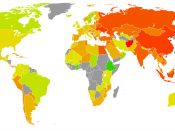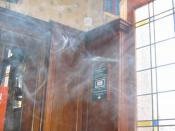SMOKING ON CAMPUS
Today, as in every other day of the year, more than 3,000 adolescents in the United States will smoke their first cigarette on their way to becoming regular smokers as adults (NCI 1994). A number of students on campus are habitual smokers because smoking is addictive; furthermore, unless repressed, it leads to many health complications. The report by the National Cancer Institute on smoking declares that cigarette smoking in the United States clearly outweighs any other factor, whether voluntary or involuntary, as the cause of death (1).
According to a report by U.S. Department of Health and Human Services, an estimated 2 million teenagers continue to smoke, and more than 100,000 youths age 12 and under are habitual smokers. Nearly 20 percent of high school seniors smoke cigarettes daily (22). Smoking is a major cause of oral, laryngeal and esophageal cancers; is a contributory factor in cancers of the bladder, kidney, and pancreas; and may play a role in cancers of the stomach, uterus, and cervix.
Each year, more people die prematurely from smoking than die from automobile accidents, drug abuse, AIDS, and alcohol combined (USDHS 1989). The report by U.S. Department of Health and Human Services suggests cigarette smoking to be responsible for 30 percent of all U.S. cancer deaths--about 145,000 each year--and nearly 85 percent of all lung cancers (17).
Smoking leads to numerous cardiac complications. The USDHS report of 1989 mentions that people who smoke heavily are at twice the risk of dying of heart attack than nonsmokers (18). Narrowing of the coronary arteries that feed the heart causes coronary heart disease, a direct consequence of smoking and the most common form of heart disease. According to USDHS, 30 percent of CHD deaths--about 170,000 each year--are attributed to cigarette smoking (18).
KHAN 2
Smoking has been found to lead to chronic obstructive lung disease, Emphysema, which according to the Department of Health causes about 50,000 deaths each year. Emphysema has become one of the chief causes of chronic disability in the United Sates; about 2 million persons suffer from it, at least a quarter of whom are so seriously handicapped that they cannot work or maintain a household (18).
Smokers are at a higher risk of developing peptic ulcers, caused by a sore or hole in the lining of the stomach or duodenum (the beginning of the small intestine), ultimately leading to increased incidences of sickness and deaths from them. Smoking is also found to be a major contributor to the recurrence of duodenal ulcers. Smoking is the most prominent risk factor for peripheral vascular disease, a condition in which the arteries that carry blood to the arms or legs become narrowed or clogged. An association between smoking and cerebrovascular disease in younger age groups has also been reported. Thrombus formation, another complication, has also been found to develop as a consequence of smoking.
Breathing environmental tobacco smoke produced by a smoker is "passive smoking," which amounts to very much the same thing as smoking, even if the smoke is secondhand. Reports by the Surgeon General and the National Academy of Sciences have concluded that involuntary smoking can cause lung cancer in healthy nonsmokers. In fact, in a report by USDHS, nonsmoking spouses have been found to have nearly a twofold risk of developing lung cancer if their spouse is a heavy smoker (19). The highly annoying and physically irritating tobacco smoke serves to worsen the symptoms of asthma, chronic bronchitis, allergies and other complications. Children of smoking parents are at a greater risk from respiratory infections and disorders compared to adolescents of nonsmoking parents. According to Mayo Clinic, secondhand smoke may be even more dangerous in some ways than the mainstream smoke drawn directly into a smoker's lungs. "It [Environmental Tobacco Smoke] contains twice as much tar
KHAN 3
and nicotine per unit volume as does smoke inhaled from a cigarette. It contains three times as much of a cancer-causing compound called 3,4 benzpyrene, five times as much carbon monoxide and possibly 50 times as much ammonia. Secondhand smoke from pipes and cigars is equally harmful if not more so" (qtd. in Cordry: 27). Hence, nonsmokers are involuntarily subjected to harmful environmental tobacco smoke because they share the same air space.
Complications such as spontaneous abortions, pre-term births, low weight babies, and fetal and infant deaths are often observed when pregnant women smoke. Babies exposed to secondhand smoke are at a higher risk of mortality by contraction of sudden death syndrome (SID). A mother's smoking habits have a detrimental effect on the baby's health after its birth. The baby is subjected to harmful nicotine from the milk during nursing. An increased risk of bronchitis and pneumonia has also been reported in babies if people smoke nearby. Physicians believe that smoking during pregnancy accounts for 20 to 30 percent of low-birth-weight babies, up to 14 percent of pre-term deliveries, and at least 10 percent of all infant deaths (ALA 1998).
Workers that are exposed to dust and other harmful substances in their work environments face an additional health risk if they smoke. In the report by the U.S. Department of Health and Human Services, published in 1989, it was declared that Asbestos workers who do not smoke have a fivefold risk of lung cancer over nonsmokers who are not exposed to asbestos. Those who work with asbestos and also smoke cigarettes have a fifty-fold risk (20).
Smokers that utilize oral contraceptives have been found to be at a higher risk to strokes and heart attacks. Smoking has been reported to cause disturbances in the medication of patients. Smokers taking theophylline may need larger doses of this bronchodilator, although dose reductions can be made if they stop smoking. Smoking will inhibit a full therapeutic response in patients taking propranolol and nifedipine for angina pectoris. Hence, smoking may lead to larger
KHAN 4
or more frequent doses of drugs or even to other medications. In other cases it has been observed to inhibit full therapeutic responses.
Tobacco companies, each year spend billions of dollars in advertising their products. Newspapers, magazines, and every other form of media are flooded with cigarette ads. Youths are bombarded by tobacco commercials, a major factor contributing to the rise in the teen smoking trend. In doctor's waiting room, the mainstream magazines like Time or Vanity Fair feature more cigarette ads on their back covers. Advertisements of tobacco featuring characters and situations symbolizing manliness, offer a delightful appeal for it in youths. Tobacco companies offer sponsorship in almost all major sporting events ranging from grand prix to soccer. Many channels periodically broadcast advertisement of cigarettes during live coverage of sport events because tobacco corporations are the major sponsors. Hollywood blockbusters like Superman II and Independence Day featuring scenes and heroic characters enjoying the 'lust' of cigarettes and cigars offer temptation for tobacco to the young.
There are numerous studies that show that nicotine speeds up the metabolism and suppresses appetite--a big issue with girls concerned about their weight. Most teenage girls, once they start smoking regularly, may gain weight when they quit. Research also shows that quitting smoking without changing eating or exercise habits result in weight gain, regardless of age. Such health issues also prompt teenagers to instigate smoking habit and is a major factor hindering them in their effort of terminating tobacco use.
Tobacco Companies claim that smokeless tobacco is a harmless substitute to normal cigarettes. If the dangers associated with using tobacco were merely a result of smoking, then smokeless tobacco might be a safe substitute. However, components of tobacco that is chewed or kept between the cheek and gum are absorbed directly through the skin, rather than inhaled. This direct absorption creates dangers of its own. According to the National Cancer Institute (NCI),
KHAN 5
users of smokeless tobacco face increased risks of cancers of the mouth, pharynx (throat), larynx (voice box), and esophagus (NCI 1998, 2).
The introduction of filtered and light cigarettes by tobacco companies claiming to reduce its detrimental effects is misleading. Harold V. Cordry emphasizes:
Adenocarcinoma, a variety of lung cancer that was once rare, is now more common than any other. Scientists believe that it is caused chiefly by filtered and light cigarettes, because smokers draw more strongly through filters and lights to get a jolt of nicotine, causing the carcinogens in the smoke to penetrate deeply into the fine branches and air sacs of the lung, where adenocarcinomas tend to develop. (31)
Tobacco companies, in order to keep their products in the market and to attract customers to their products, release new brands from time to time with different slogans pertaining to be a better substitute then before.
Some offer arguments against the detrimental effects of smoking, referencing its positive influences. Rosalind B. Marimont, a retired mathematician and scientist, actively involved in health policies denounces the high publicity accounted to the smoking issue, on the basis that other issues such as alcoholism and drugs are more corrosive for a society. She even offers an overview of its positive effects stating that smoking suppresses obesity. Smokers are at a low risk of contracting ulcerative colitis. She also enlists the effectiveness of smoking in causing alertness, allaying depression and anxiety. Marimont presents evidence of smoking as an inhibiting agent against Alzheimer's and Parkinson's disease, to support her argument (34).
The harmful effects of smoking clearly overweigh its benefits. Hence, A strict line of action is needed which can eradicate this menace. The University should formulate and enforce a smoking prevention program. First and foremost, brief sessions should be included in the curriculum that gives insight on the disastrous consequences of smoking. The sessions should be
KHAN 6
distributed over 4 years. The sessions can be as affective when offered through health, physical education, science, English, or social studies classes. Adequate and thorough training of teachers on the issue is essential to present them as role models for students. Teachers can impart information accurately and effectively only if they receive adequate training. A report by the US Department of Health and Human Services mentions that in a 1976 survey of public school teachers (grade 1-12) conducted by the American Cancer Society, one of three teachers (32 percent) reported having received training in smoking education (16). Elected class members having detailed insight about the problem should be appointed. Although training may involve costs and logistical problems, research shows that the investment is critical for a positive impact. Pressure should be brought on the state legislature to fund health education training programs. Health educators, nurses, physicians, school administrators, public health personnel, and college health educators should all be involved in pressing for these goals.
Active participation and involvement of teachers and student representatives in class to highlight the consequences of this threat can be an effective tool to combat it. A student's decision to smoke is often influenced by media, parents, and peers. Support of parents and community to inhibit this hazard of teen smoking is mandatory for the success of this cause. Children should be encouraged by their parents to attend programs designed to propagate awareness of this issue. A report by the National Cancer Institute states that, since 1980, smoking prevalence rates among youth essentially have leveled off after previous years of decline. This suggests that non-smoking programs introduced in schools in the 1970's were successful in affecting students (2).
Smoking awareness week, a weeklong event aimed at increasing awareness among students on the implications of tobacco use should be held every semester. The event should feature speeches by health experts on the issue. Flyers stressing the harmful consequences of
Khan 7
smoking should be distributed among the students. Video shows highlighting the grave consequences of smoking should be shown in class, followed by a brief session of question and answers on the subject of smoking. Encouragement for students to take part in healthy activities to keep their minds off smoking should be stressed. Hence, active involvement in sports can help deviate students from the thought of cigarettes.
Penalties and fines on smoking, possessing or distributing tobacco should be imposed on-campus. University police department should be assigned the duty of enforcing such laws. Penalties may include fines and warnings, even suspension from University. Such measures will refrain students from tobacco usage on campus for fear of being fined. In parts of California, Florida, Texas and Illinois, for example, fines ranging from 25$ to 250$ may be doled out to convicted underage smokers. Statistics indicate that such legal measures have proved very productive. Lisa McLaughlin of Time concludes that "the awareness of health risks and the prospect of parental punishment rarely seem to deter middle and high school students from experimenting with cigarettes. But a Florida program has found that the threat of legal penalties can reduce teen smoking up to 40%" (80).
The University television and radio should air programs featuring health professionals from the University Health Department and medical centers across City. These programs should highlight the damaging effects of smoking and should point out measures to inhibit it. Awareness of immediate physical effects of smoking such as shortness of breath and stained teeth has an increased learning influence on adolescents. Hence, compared to long-term health effects of smoking such as cancer and heart disease, the immediate effects should be emphasized more. Apart from radio and television, the university magazines and newspapers should also feature articles stressing the tobacco issue. The articles should develop skills enabling students to make decisions, solve problems, and refuse cigarettes. Printed materials focused on this addictive trend
Khan 8
should be available in canteens, lounges and posted on message boards. Thus, media can prove to be a milestone in tackling this hazard. According to a report, Nearly 40 million Americans have stopped smoking since the mid 1960's when the first Surgeon General's report on smoking was issued (USDHS, 1989).
The U.S. Surgeon General calls cigarette smoking the "chief, single, avoidable cause of death in our society and the most important public health issue of our time" (qtd. in Prevent 1). In my opinion, a strictly enforced smoking prevention program incorporated into the curriculum can serve as the best possible solution to inhibit and prevent the catastrophic consequences of tobacco use. It ensures awareness among students to the detrimental affects of smoking alongside their college education. Most students' refrain from openly discussing matters such as smoking with parents and other relatives but are much more frank with other students about their age. Hence, open interactions and discussions among students on the issue are bound to yield positive results. Also, as the sessions will be distributed over four years, each session can serve as a booster towards the commitment of 'no smoking.' Apart from academic studies, educating college students on the damaging implications of smoking can effectively curb this addictive threat.
Works Cited
United Sates. National Cancer Institute. Schools Programs To Prevent Smoking. Washington: 1994.
---. ---. State and Local Legislative Action to Reduce Tobacco Use. Washington: 2000.
---. ---. Cancer Facts: Questions and Answers about Smokeless Tobacco and Cancer. Washington: 1998
---. Dept. of Health and Human Services. Quit for Good: A Practitioner's Stop-Smoking Guide. Washington: 1989.
---. American Lung Association. Smoking. Washington: 1998.
McLaughlin, Lisa. "In Brief" Time 3 Dec. 2001: 80.
Cordry, Harold V. Tobacco. California: Santa Barbara, 2001.
Marimont, Rosalind B. "The Dangers of Smoking Are Exaggerated." Teen Smoking. Ed. Mary E. Williams. San Diego: Greenhaven Press, 2000. 32.


